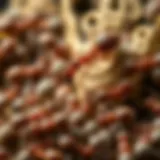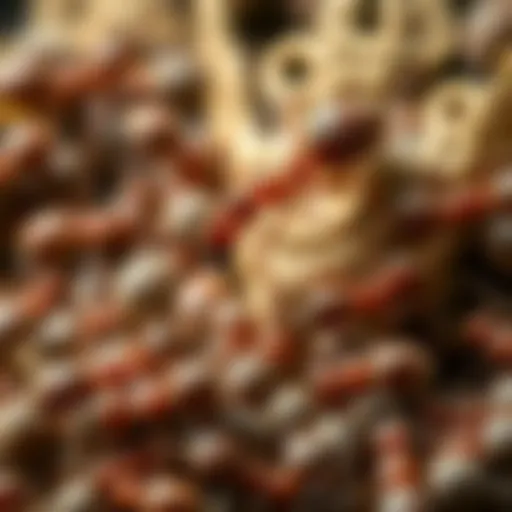Effective Solutions for Termite Management
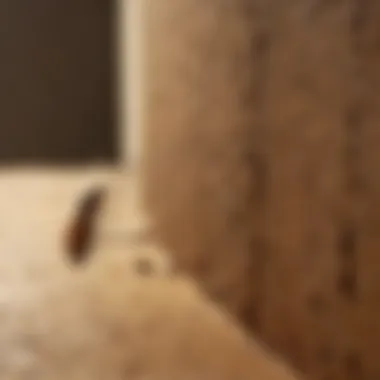

Intro
Termites can be a homeowner's worst nightmare. These tiny insects often go unnoticed until their destructive work has already taken a toll on your property. Once they set their sights on wood structures, these pests can cause significant damage, leading to costly repairs. This article aims to shed light on effective methods for managing termite infestations, focusing specifically on spray treatments. By understanding pest identification, prevention methods, and DIY solutions, homeowners can take proactive steps to safeguard their homes.
Pest Identification
Knowing whether you have a termite problem is the first step in effective pest management.
Common Household Pests
While numerous pests can infiltrate your home, termites are particularly insidious. The most commonly encountered species in urban settings include:
- Subterranean Termites: They live underground and emerge to feast on wooden structures.
- Drywood Termites: These insects infest wood directly, often found in dry, solid timber.
- Dampwood Termites: They prefer moist, decayed wood and are commonly found in humid areas.
Signs of Infestation
Recognizing the signs of a termite infestation early can save you both time and money. Keep an eye out for:
- Mud Tubes: These pencil-sized tunnels made of dirt can be found near foundations.
- Discarded Wings: After breeding, termites shed their wings, which may be found scattered around.
- Wood Damage: Hollow-sounding wood and tiny holes could indicate termite activity.
"The sooner termites are identified, the easier it is to manage them effectively."
Prevention Methods
Preventing termites from invading your home is just as crucial as managing an existing infestation.
Environmental Modifications
Simple changes around your property can significantly reduce termite risks. For example:
- Keep firewood, lumber, and paper away from the foundation.
- Ensure proper drainage to avoid moisture buildup.
- Use gravel rather than mulch in gardens to deter termite access.
Home Maintenance Tips
Routine home inspections and maintenance tasks can limit termite attraction points. Consider the following:
- Seal cracks and crevices where termites may enter.
- Regularly check for leaks in plumbing or roofs, which can create damp environments.
- Make sure any wood in contact with soil, like fence posts or deck supports, is treated or capped.
DIY Pest Control Solutions
For homeowners looking to take matters into their own hands, DIY options can provide effective results.
Natural Remedies
Several natural solutions can deter termites without relying solely on chemical sprays. Possible options include:
- Nemotodes: These microscopic roundworms seek out termites as food.
- Orange Oil: Contains d-limonene, which is toxic to termites.
- Boric Acid: A natural mineral that can act as a slow-acting poison once ingested by termites.
DIY Traps and Barriers
Constructing barriers or traps may help manage termite populations. Some strategies include:
- Create physical barriers using steel mesh or concrete around foundations.
- Set traps with bait stations that attract and kill termites, helping to monitor infestations.
Understanding Termite Infestations
In the realm of home ownership, few issues loom larger than the threat posed by termite infestations. Understanding how these pests operate is crucial, as it lays the foundation for effective management strategies. Ignoring these insects can lead to significant structural damage, financial loss, and a host of unforeseen headaches. By gaining insight into termite behavior and identifying the signs of their presence, homeowners can take proactive steps to protect their properties. This section provides a closer look at the varieties of termites, signs of their activity, and why this knowledge is invaluable.
Types of Termites
Subterranean Termites
Subterranean termites are the most common variety, and they could be lurking right under your feet. They thrive in soil and are notorious for traveling above ground in mud tubes to reach food sources. A notable characteristic of these termites is their colony structure, often numbering in the millions. This immense population allows for rapid damage to wooden structures. It is essential to be aware of their presence, as their ability to move undetected makes them particularly dangerous. They can weaken a home’s foundation before the homeowner ever notices something amiss.
One critical aspect of subterranean termites is their moisture dependency. They prefer damp environments, which means areas with poor drainage are prime spots for their colonies. Homeowners must ensure that their landscaping and drainage are properly managed to limit potential habitats for these pests.
Drywood Termites
In contrast to their subterranean cousins, drywood termites do not require contact with soil. They infest the wood they consume, making their presence more challenging to detect until significant damage occurs. These termites often start their colonies in the wood itself, leading to a more localized issue. A key characteristic of drywood termites is their ability to thrive in relatively dry wood, such as that found in furniture and structural beams. This adaptability ensures that they can establish colonies without needing high moisture levels.
Drywood termites require a different approach for control. Since they reside within the wood they eat, conventional sprays may not penetrate deep enough to reach them. Therefore, specialized treatments, such as heat or fumigation, may be necessary—this can be a costly and involved process.
Formosan Termites
Formosan termites can be seen as a particularly aggressive variant of subterranean termites. Primarily found in warmer climates, they are infamous for their relentless appetite and large colonies. Their defining feature is their ability to create extensive underground nests, which often go undetected until significant damage has occurred. They can consume wood at alarming rates, creating extensive structural damage in just a matter of weeks.
One drawback for homeowners is that Formosan termites often blend in with other species, making identification tough. By being aware of their geographic prevalence and unmatched destructiveness, homeowners can prioritize vigilance in keeping their properties termite-free.
Signs of Termite Activity
Visual Indicators
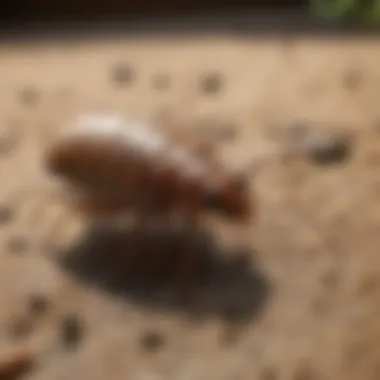

Once you know what to look for, spotting termites isn’t as daunting. Visual indicators often include hollowed wood, mud tubes, and discarded wings. These signs serve as red flags that should prompt immediate attention. Recognizing these indicators allows homeowners to act before the damage piles up.
The key to addressing termite infestations lies in vigilant inspection.
Damage Assessment
Once visual signs are identified, assessing the damage becomes paramount. A thorough inspection can reveal the extent of the infestation and the structural integrity of the affected areas. This assessment helps homeowners decide on the most appropriate action—whether to utilize sprays, call in professionals, or take a more hands-on approach.
Swarm Behavior
During specific seasons, termites swarm as part of their reproductive cycle. This phenomenon is a significant indicator of an infestation. Swarming termites, often mistaken for flying ants, can leave homeowners puzzled. Recognizing this behavior can provide a clear indication that action is needed quickly. Observations of swarm patterns can also help pinpoint where the colonies may be situated, directing treatment to the right areas.
"Understanding the behavioral patterns of termites can be the difference between a minor repair and a major renovation."
In summary, recognizing the types of termites and signs of their activity is fundamental for effective management. Equipped with this knowledge, homeowners can tackle potential infestations head-on, ensuring their spaces remain secure and structurally sound.
Chemical Sprays for Termite Control
Addressing termite infestations effectively often requires a multi-faceted approach, with chemical sprays playing a critical role in termite management. The importance of using chemical sprays cannot be overstated, as they provide quick and potent solutions against these destructive pests. In many cases, these sprays can significantly reduce the termite population in a short period, making them an appealing option for homeowners facing infestations.
Chemical sprays fall into various categories, including conventional pesticides, insect growth regulators, and boric acid solutions, each offering unique benefits and considerations. It's crucial to understand not just the effectiveness of these products but also their applications, safety precautions, and environmental impact. In the following sections, we'll look deeper into each type, helping you make well-informed decisions when managing termite problems in your home.
Conventional Pesticides
Advantages and Disadvantages
Conventional pesticides, such as chlorpyrifos and fipronil, have been widely used in termite control. Their main advantage lies in their rapid action; they can kill termites upon contact or through ingestion almost immediately. This rapid effect is often crucial for urgent situations where extensive damage is being done.
However, the potential drawbacks of these pesticides can’t be brushed aside. Prolonged use can lead to a build-up of resistance in termite populations, making them less effective over time. Additionally, these chemicals can pose health risks to pets and humans if not handled properly. Homeowners need to weigh these factors carefully when deciding on their approach to termite control.
Application Techniques
Applying chemical sprays requires a systematic approach for maximum efficacy. There are several techniques available. One common method is the spray-and-soak technique, where the pesticide is applied directly to the wood and surrounding areas. This ensures that the termites come into contact with the treated surfaces. Another effective method involves trenching, where a trench is dug around the foundation and filled with pesticide solution, creating a barrier against subterranean termites.
Understanding the characteristics and proper execution of these application methods can make all the difference in terms of effectiveness and safety. The right choice will depend on the specific situation, including the type of termites involved and the severity of the infestation.
Safety Precautions
Safety measures are of paramount importance when using chemical sprays. Understanding the compounds involved is essential for minimizing risks to health and the environment. Homeowners should always wear protective gear, such as gloves and masks, when applying these products. It is also advisable to ensure that children and pets are kept away from treated areas until the product has completely dried.
Moreover, proper ventilation in the spaces where the pesticide is applied can help dissipate any harmful fumes. Following the manufacturer's guidelines is non-negotiable; any deviation can compromise both safety and the product's effectiveness.
Insect Growth Regulators
Mechanism of Action
Insect growth regulators (IGRs), such as noviflumuron and methoprene, operate on a different principle compared to conventional pesticides. IGRs work by disrupting the development and growth cycle of insects. They inhibit molting, which affects the termites' ability to mature into reproducing adults, thereby slowing population growth. This means that while they are not immediate killers, they effectively manage long-term pest populations.
Their unique mechanism makes them a valuable choice for those looking not just for immediate relief but also for lasting control over termite populations.
Effectiveness
The effectiveness of IGRs can be a double-edged sword. While they do an excellent job in controlling populations over time, they might not be the best solution for immediate severe infestations. Homeowners need to recognize that utilizing IGRs is more of a preventive measure rather than an immediate fix. Depending on the specific circumstances, IGRs could serve as an adjunct to conventional methods instead of a standalone solution.
Usage Guidelines
Using IGRs requires specific knowledge and guidelines. They generally need to be applied in areas frequented by termites, such as along their foraging trails. Regular check-ups and reapplications are necessary to achieve and maintain effectiveness. Homeowners also should consider integrating IGRs as part of a broader pest management strategy alongside other chemical treatments for optimal results.
Boric Acid Solutions
Properties and Applications
Boric acid is renowned for its effectiveness against various household pests, including termites. Its primary characteristic is that it is relatively safe for humans and pets when used as directed, which makes it an attractive option for many homeowners. Boric acid works by disrupting the termite's digestive system, leading to eventual decline in their population.
This product can be applied in various ways, such as via a spray solution or when mixed into bait stations. Its versatility allows it to be used in various environments without posing significant health risks, unlike some harsher pesticides.
Effectiveness in Termite Control
The effectiveness of boric acid as a termite treatment is widely acknowledged. Its slow-acting nature means that termites may take it back to their colonies, affecting others in their group, which can lead to a much more extensive control over time. However, for immediate infestations, it might not yield the quickest results compared to conventional pesticides, but it is optimal for long-term management.
Environmental Impact
Boric acid's lower toxicity levels also make it an environmentally friendly option. It poses significantly less risk to both beneficial insects and the surrounding ecosystem when used correctly. Homeowners focusing on eco-friendly solutions will find it a commendable choice. Even though boric acid is safer, it’s still essential to apply it correctly to prevent unintended exposure.
Natural and Organic Alternatives
When it comes to keeping those pesky termites at bay, the conversation doesn't end with chemical sprays. In fact, natural and organic alternatives are becoming more popular amongst homeowners concerned about health and environmental impacts. These alternatives offer a less toxic option that often comes from readily available household items or plants. As we dive into this world, it’s vital to consider the efficacy, safety, and practicality of these methods.
Essential Oils
Types of Essential Oils


Essential oils have made quite a name for themselves in pest control. Not only do they smell nice, but they have properties that are quite detrimental to termites. Oils like clove, orange, and neem pack a punch against these wood-destroying creatures. What's remarkable about these oils is their ability to paralyze or repel termites rather than just kill them outright. Clove oil, for example, contains eugenol that disrupts their nervous system, making it a popular choice. However, it's worth noting that while these oils can be effective, they require repeated applications because they tend to evaporate quickly compared to synthetic options.
Application Methods
The application of essential oils varies widely, which is part of what makes them appealing. You can mix them with water, making spray solutions that can be applied directly onto infested areas. Alternatively, infused oils can be used in a more targeted manner—dabbing some directly onto wood surfaces where signs of termites are noticed. It's easy to incorporate essential oils into a homeowner’s arsenal since they can fit right into cleaning routines. But one should be cautious about applying too much, as some oils can stain surfaces or have adverse effects on children and pets.
Effectiveness Against Termites
While essential oils are touted for their natural composition, their effectiveness can be a bit hit-or-miss. Studies suggest that while they can help in low-level infestations and act as preventive barriers, they may not entirely eradicate larger colonies. Thus, they tend to be more suitable for proactive measures rather than full-blown treatment solutions. Homeowners often find comfort in their natural scent, but the key characteristic here is a bit of patience and consistency needed for repeated applications to really keep those termites at bay.
Diatomaceous Earth
How It Works
Diatomaceous earth (DE) is no ordinary substance; it's composed of fossilized algae and has a unique abrasive quality. When termites come into contact with it, the fine powder scratches their exoskeleton, leading to dehydration. Its natural origins are appealing to many, and it's quite safe for humans and pets when used correctly. Crucially, it helps with a wide range of insects, making it versatile for your pest management toolkit. It's widely available in garden centers, so it's an accessible option for most homeowners.
Application Techniques
Using diatomaceous earth is as simple as sprinkling it around entry points, moist areas, or any areas noted for termite activity. You might want to focus on spots where wood meets soil since termites enjoy their cozy hideouts there. A key takeaway is that for optimal effectiveness, the powder needs to stay dry; once wet, its effectiveness dips significantly. It's a straightforward method, but homeowners should apply it cautiously, ensuring it doesn’t get disturbed too much, as airflow can cause it to disperse.
Benefits and Limitations
Diatomaceous earth shines for its multi-faceted nature; not only does it target termites, but it can also manage other pests. It’s safe and doesn’t involve chemicals, appealing to those wanting a safer option. But on the flip side, it may take time to see results, as it doesn’t offer instant gratification. Homeowners seeking a quick fix might find it less appealing if the infestation is severe. It's vital to recognize that while it offers benefits, it's not a standalone solution for heavy infestations.
Homemade Sprays
Common Ingredients
Homemade sprays are an intriguing alternative, often made with common kitchen ingredients. Vinegar, soap, and essential oils find themselves in many DIY recipes. For instance, vinegar has a reputation for its acidity, which can help in cutting down a termite population when sprayed directly. The unique feature of homemade sprays is their cost-effectiveness; many times, you can mix them up with what you have laying around. However, effectiveness can vary, and it’s important to experiment with proportions for the best results.
DIY Recipes
Creating your own termite spray can be quite a project. A simple recipe could involve mixing one part vinegar with two parts water and a few drops of dish soap. This concoction works as both a repellent and a killing agent. What’s appealing here is the flexibility; you can tweak the recipe according to your findings and experiences. On the downside, these sprays can be less effective compared to commercial products, especially for serious infestations, so preparedness is key.
Application Tips
When it comes to application, timing is everything; you’ll want to spray especially in damp areas where termites are likely to nest. Ensure to apply it during the cooler parts of the day to maintain efficacy. Be generous but not wasteful, as you want it to soak into areas where termites might be hiding. Interestingly, mere vigilance during routine applications can keep termites on their toes, delaying potential infestations. Keep in mind that efficacy is a process; repeated treatments will up the odds of success.
Professional Pest Control Options
When dealing with termites, the role of professional pest control cannot be understated. It’s crucial for homeowners to weigh the benefits and implications when considering this pathway. Trained professionals bring a wealth of experience, knowledge, and specialized tools that are often unavailable to the average individual. Additionally, tackling a termite infestation can be daunting and complex, particularly when the extent of damage is uncertain.
Benefits of Professional Intervention:
- Expertise: They can identify the species of termites and recommend the most effective treatment methods.
- Advanced Equipment: Many pest control services use treatments and tools that go beyond over-the-counter products.
- Time-Saving: They can work quickly, helping to minimize damage and stress for homeowners.
"In many cases, when a home is under siege by termites, it’s best to leave it to the professionals. Not only do they know the ins and outs, but they can often save you a headache down the line."
Ultimately, choosing professional pest control services can mean a higher upfront cost but could lead to long-term savings and peace of mind. Now, let’s dive into specific scenarios when reaching out for help becomes the most prudent choice.
When to Consider Professional Help
Extent of Infestation
Extent of infestation is a key factor that determines whether to engage professional help. When termites have established a colony, the damage can escalate quickly, leading to extensive structural issues. The telltale signs—like mud tubes or hollow-sounding wood—often signal that intervention is urgent.
A major aspect of this is recognizing damage that may not be visible. Professionals typically have access to specialized equipment such as moisture meters and thermal imaging cameras, allowing them to detect infestations that casual observation might miss. When the infestation reaches a significant level, relying on DIY methods often proves futile.
Health and Safety Concerns
When it comes to pest control, safety should always be a primary concern. Do-it-yourself treatments may expose you and your family to toxic substances that can lead to health complications. This is particularly true for homes occupied by children or pets. Professional pest control companies prioritize health and safety, employing practices that mitigate risks while effectively tackling termite issues.
It's wise to engage experts who can ensure that treatments are applied in a safe manner and monitor air quality during and after treatment. Although professionals may use strong compounds, their knowledge allows them to apply these substances safely, minimizing exposure risks.
Time Constraints
Life can be hectic; balancing work, family, and other commitments often leaves little time for tackling considerable home repairs or pest control. A professional pest control service can alleviate the burden of time constraints.
They can provide timely assessments and implement treatment plans swiftly, allowing you to focus on other important aspects of your life. Moreover, given the complexity of termite behaviors and the potential damage they can cause in a short timer span, quick response can make a world of difference. Leaving it to professionals can save precious time and possibly avert more extensive—and costly—damage.
Types of Treatments Offered
Fumigation Methods
Fumigation represents a comprehensive approach to dealing with termite infestations, especially when the problem is extensive. This method involves sealing the structure and injecting gaseous pesticides designed to penetrate all wood within the treated area. It’s a powerful solution, often viewed as the go-to when conventional methods fail or when swarms are present.
The downside to fumigation is that it can be costly, not to mention it requires occupants to vacate the premises during treatment. However, its effectiveness cannot be dismissed, providing a high level of assurance in eradication.
Soil Treatment
Soil treatment, on the other hand, offers a proactive solution by applying barriers in the soil around and beneath your home. This method targets subterranean termites and prevents them from entering and establishing a colony in your home. It’s generally less disruptive than fumigation and can even be part of a routine pest control program.
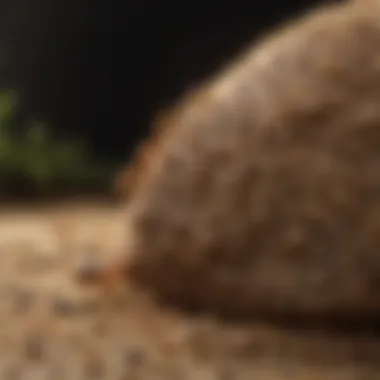

However, the effectiveness of soil treatment relies heavily on proper application techniques. If not done right, it might not provide the expected protective barrier, making it essential to consult seasoned professionals.
Localized Treatments
Localized treatments are designed to tackle specific areas where termites are detected, making them less invasive and often more cost-effective. Techniques such as drilling into wood to apply pesticides can target affected areas without the need for extensive preparation or evacuation of the home.
The trade-off, however, lies in their limited nature—because localized treatments may not address larger infestations, ongoing monitoring and potentially further treatments may be necessary.
Evaluating Pest Control Services
Certifications and Experience
Before selecting a pest control service, evaluating certifications and the experience of the technicians can impact the overall effectiveness of the treatment. Companies with established credentials are often more knowledgeable about various pest issues, including termites, leading to more favorable outcomes.
Additionally, seasoned professionals can identify not just the infestations but also the conditions that might have led to them, allowing for more tailored interventions.
Methods and Products Used
Understanding the methods and products a pest control service employs is critical for ensuring that you are choosing a safe and effective option. Many companies have adapted to using more environmentally friendly products, which can be especially important for families.
Moreover, some pest control professionals are on the cutting-edge of technology, utilizing tools that integrate things like bait systems or monitoring traps—it’s worth considering which methods align with your philosophy of pest management.
Cost Considerations
Finally, when it comes to cost considerations, evaluating the financial aspect of professional pest control services helps in making informed decisions. Costs can vary significantly based on the severity of infestation, methods being used and even regional pricing differences.
While the expense may seem significant upfront, remember that not addressing termite issues can lead to costly repairs later on. It’s vital to weigh the cost against the potential savings and peace of mind that come with professional assistance.
Preventing Future Infestations
The significance of preventing future infestations is vital for homeowners who wish to keep their properties safe from termite damage. It's one thing to tackle an existing problem, but avoiding the issue altogether can save time, money, and a lot of stress down the road. By laying down a good groundwork in terms of preventive measures, homeowners can create an environment that is less inviting for termites to thrive.
Landscape and Property Management
Proper Drainage
Proper drainage isn't just a buzzword thrown around by gardeners. It's an essential component in the battle against termites. When water collects around the foundation, it creates a perfect habitat for subterranean termites, who thrive in moisture-rich conditions. The main advantage of good drainage is it stifles the conducive environment these pests need to flourish.
One unique feature of proper drainage is its interplay with your landscaping. It's not just about the yard; it's about ensuring that your water flow doesn't encourage any water buildup near the house. Downspouts, for instance, should direct water away from the foundation. The disadvantage here can be the investment in landscape adjustments if water management wasn't considered from the start.
Wood Management
Wood management is a smart choice for termite prevention. When wood is used in construction, whether it be decks, fences, or siding, its maintenance is crucial to stave off termite infestations. Keeping wood dry and properly treated can deter these pests significantly.
A key characteristic of wood management is the choice of materials. Opting for pressure-treated wood or naturally resistant varieties like cedar or redwood can provide an additional layer of protection. However, it does need ongoing vigilance, as even treated wood can become susceptible if not maintained. Ignoring worn-down areas can be an open invitation for termites to make themselves at home.
Regular Inspections
Implementing regular inspections is a proactive measure that enhances the longevity of your termite prevention strategies. Set schedules for inspecting not just the interior of your home but also areas like the basement and crawl spaces.
The beauty of routine inspections lies in their potential to catch issues early. A little problem can escalate quickly if left unchecked, so it’s best to make snapshots of your home’s health regularly. The downside is that these inspections require commitment and a keen eye. Without routine checks, you might miss early warning signs, leading to larger expenses in the long run.
Ongoing Monitoring Techniques
Traps and Baits
Using traps and baits is like setting a trap for unwelcome guests at a party. They serve as an early warning system to detect the presence of termites and manage them before an infestation becomes severe. The point of these tools is to lure termites in, either to eliminate them or to identify hotspots within your property.
The unique feature of traps is that they can be placed in strategic locations around the property. However, relying solely on traps can be misleading; termites sometimes avoid them, preferring hidden routes. Therefore, they should complement other monitoring strategies rather than serve as the only measure.
Routine Inspections
Rounding back to routine inspections, they serve as a doubly effective method when combined with traps and bait systems. Regular checks keep the control measures fresh in your mind. The downside, though, is that this method requires both diligence and the ability to evaluate potential termite damage accurately.
Technology Integration
Leveraging technology for termite monitoring has become increasingly popular for homeowners. Various devices can alert individuals to moisture levels or vibrations that might suggest termite activity. These tech tools might even provide actionable data regarding pest movement.
While technology integration makes monitoring more efficient, one must ensure they have thorough understanding of how these gadgets work. Misinterpretation can lead to unnecessary follow-up treatments, elevating costs rather than helping to manage them.
Educational Resources and Tools
Online Resources
In this digital age, many resources are available online for termite prevention. Homeowners can find articles, videos, and forums discussing various strategies to implement.
These online resources are beneficial for accessibility and variety, yet they can be overwhelming without proper curation. Having too much information might make it challenging to identify what’s relevant or effective. Picking reliable sources is key here.
Community Workshops
Community workshops provide an interactive way to learn about termite management locally. These gatherings often connect you with pest control experts who can offer advice tailored to your specific regional issues.
A special feature of these workshops is the community aspect, fostering a network of neighbors looking to safeguard their homes. However, they're bound by schedules and accessibility — missing one could mean waiting for the next opportunity.
Literature and Guides
Books and printed guides can offer thorough insights into termite prevention. They often provide structured information that can serve as a reliable reference.
While literature and guides are great for in-depth understanding, one must remember they can't replace practical experience. These resources are static; they may not reflect the latest methods or products. Staying updated with new publications is essential in a fast-changing field like pest control.




